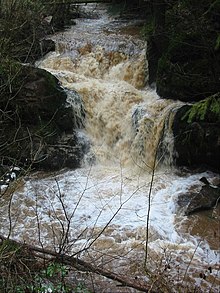
Fairy Loup is a waterfall located on Byre Burn, a tributary of River Esk, in Dumfries and Galloway, Scotland.[1]
The waterfall's name originates in a local legend of "a fairy having leaped from one side to the other",[2] and is an example of a regional tradition of associating small streams with fairies.[3] This waterfall was one of several features near Langholm described in the poetry of Hugh MacDiarmid.[4]
A 14.5-kilometre (9.0 mi) loop trail passing through Canonbie and Rowanburn gives access to the waterfall.[5] Fly-tipping has been a problem in the area.[6]
See also
[edit]References
[edit]- ^ Ordnance Survey 1:25,000 scale Explorer map series, sheets 309-470
- ^ Ordnance Survey 1848–1858, p. 146.
- ^ Hyslop & Hyslop 1912, p. 89.
- ^ Bold 1990, p. 18.
- ^ "The Walks". Langholm Walks Project. Retrieved 27 February 2015.
- ^ "Dumping Ground". Eskdale & Liddesdale Advertiser. 16 July 2008. Archived from the original on 27 February 2015. Retrieved 27 February 2015.
Bibliography
[edit]- Bold, Alan (1990). MacDiarmid: A Critical Biography. University of Massachusetts Press. ISBN 978-0-87023-714-0.
- Ordnance Survey Name Books. Vol. Dumfriesshire Volume 4. Ordnance Survey. 1848–1858.
- Hyslop, John; Hyslop, Robert (1912). Langholm as It Was: A History of Langholm and Eskdale From the Earliest Times. Hills and Company. OCLC 25402682.
55°05′40″N 2°56′58″W / 55.09452°N 2.94953°W
Well, that’s interesting to know that Psilotum nudum are known as whisk ferns. Psilotum nudum is the commoner species of the two. While the P. flaccidum is a rare species and is found in the tropical islands. Both the species are usually epiphytic in habit and grow upon tree ferns. These species may also be terrestrial and grow in humus or in the crevices of the rocks.
View the detailed Guide of Psilotum nudum: Detailed Study Of Psilotum Nudum (Whisk Fern), Classification, Anatomy, Reproduction